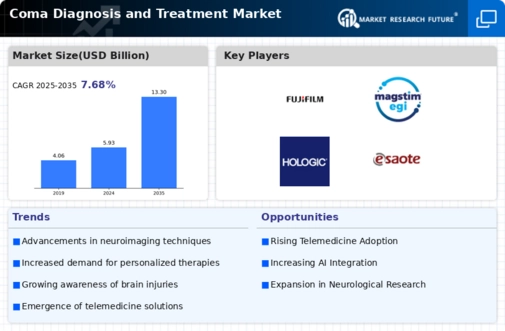Market Trends
Key Emerging Trends in the Coma Diagnosis and Treatment Market
Due to traumatic brain injuries, stroke, and neurological illnesses, coma incidence is rising worldwide, driving need for precise diagnosis and effective treatment. Diagnostic imaging technologies including MRI, CT scans, and electroencephalography (EEG) are increasing coma identification and intervention, boosting market growth. Serum biomarkers and neuroimaging indicators for coma diagnosis provide quick and exact diagnosis, focused therapy, and market growth. Market growth is driven by multimodal monitoring systems that include EEG, intracranial pressure, and cerebral blood flow monitoring to better understand coma pathogenesis and guide tailored treatment regimens. Novel coma treatments include neuroprotective medicines, neuromodulation, and stem cell therapies are being developed, expanding the market. Telemedicine platforms and remote monitoring solutions for coma patients provide real-time consultations and continuous patient monitoring, enhancing access to specialist treatment and boosting market development, especially in distant or underserved locations. Specialized neurocritical care facilities with enhanced monitoring and treatment technology are improving coma outcomes and generating demand for coma management services. Coma treatment approval and commercialization regulations affect market dynamics and product innovation, affecting market growth. Patient-centric coma management is improving market accessibility and development as physicians personalize treatment programs to patient requirements and preferences. Research, healthcare, and pharmaceutical businesses are collaborating to improve coma diagnosis and treatment, expanding the market. Enhanced neuroimaging technologies like fMRI and DTI are revealing coma etiology and enabling tailored treatment techniques, increasing market development. Comprehensive rehabilitation treatments including physical, occupational, and speech therapy are improving coma survivors' functional results and boosting rehabilitation service demand. Public health campaigns to prevent, detect, and treat comas are lowering death rates and increasing demand for specialist services. Globalization of healthcare services allows patients to receive specialist coma diagnosis and treatment across boundaries, increasing market competitiveness and innovation. Increasing investment in clinical trials and research studies on coma diagnosis and treatment is generating innovation, resulting to new diagnostic instruments and therapeutic strategies and market expansion.







Leave a Comment